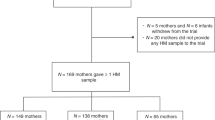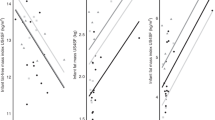Abstract
Objective:
The aim of this study was to identify the independent effect of very preterm gestation on breast milk content of biologically active proteins (secretory immunoglobulin A (sIgA), lysozyme, lactoferrin, osteoprotegerin (OPG), leptin, adiponectin and β-endorphin (b-EP)) during the first month of lactation.
Study Design:
We collected samples of transitional (6 to 8 and 13 to 15 days) and mature (20 to 22 and 27 to 29 days) milk from mothers after term (38 to 41 weeks) or very preterm (24 to 31 weeks) delivery. The levels of sIgA, lysozyme, lactoferrin, OPG, leptin, adiponectin and b-EP in the breast milk were quantified using enzyme-linked immunosorbent assay or enzyme immunoassay kits. Statistical analysis included descriptive statistics and regression analysis.
Result:
Sixty breast milk samples were collected from 15 mothers after very preterm (preterm breast milk, PBM) and 20 samples from 5 mothers after term (term breast milk, TBM) deliveries. Decrease in lysozyme, lactoferrin, OPG, leptin, adiponectin and b-EP but no change in sIgA was recorded during the first month of lactation in both TBM and PBM. The IgA, lysozyme and adiponectin were higher in PBM than in TBM, whereas concentrations of lactoferrin, OPG and leptin were higher in TBM than in PBM (P<0.05 to 0.0001). A similar pattern was seen in the lysozyme, leptin and adiponectin concentration in mature milk. Increased b-EP levels in breast milk were associated with the vaginal mode of delivery but not gestational age.
Conclusion:
Although a similar pattern of change was observed in the breast milk bioactive proteins during the first month of lactation after term and very preterm gestation, PBM is a better source of factors with antibacterial/anti-inflammatory activities but is constantly deficient in leptin, which is involved in neuroendocrine regulation.
This is a preview of subscription content, access via your institution
Access options
Subscribe to this journal
Receive 12 print issues and online access
$259.00 per year
only $21.58 per issue
Buy this article
- Purchase on Springer Link
- Instant access to full article PDF
Prices may be subject to local taxes which are calculated during checkout

Similar content being viewed by others
References
American Academy of Pediatrics. Breastfeeding and the use of human milk. Work group on breastfeeding. Pediatrics 1997; 100: 1035–1039.
Resto M, O’Connor D, Leef K, Funanage V, Spear M, Locke R . Leptin levels in preterm human breast milk and infant formula. Pediatrics 2001; 108: E15.
Zanardo V, Nicolussi S, Carlo G, Marzari F, Faggian D, Favaro F et al. Beta endorphin concentrations in human milk. J Pediatr Gastroenterol Nutr 2001; 33: 160–164.
Martin LJ, Woo JG, Geraghty SR, Altaye M, Davidson BS, Banach W et al. Adiponectin is present in human milk and is associated with maternal factors. Am J Clin Nutr 2006; 83: 1106–1111.
Goldman A, Garza C, Nichols B, Goldblum R . Immunologic factors in human milk during the first year of lactation. J Pediatr 1982; 100: 563–567.
Lönnerdal B . Human milk proteins: key components for the biological activity of human milk. Adv Exp Med Biol 2004; 554: 11–25.
Vidal K, van den Broek P, Lorget F, Donnet-Hughes A . Osteoprotegerin in human milk: a potential role in the regulation of bone metabolism and immune development. Pediatr Res 2004; 55: 1001–1008.
Ahima RS, Saper CB, Flier JS, Elmquist JK . Leptin regulation of neuroendocrine system. Front Neuroendocrinonol 2000; 21: 263–267.
Gainsford T, Willson TA, Metcalf D, Handman E, McFarlane C, Ng A et al. Leptin can induce proliferation, differentiation, and functional activation of hemopoetic cells. Proc Natl Acad Sci USA 1996; 93: 14564–14568.
Bielicki J, Huch R, von Mandach U . Time-course of leptin levels in term and preterm human milk. Eur J Endocrinol 2004; 151: 271–276.
Montagne P, Cuilliere ML, Mole C, Bene MC, Faure G . Immunological and nutritional composition of human milk in relation to prematurity and mother's parity during the first 2 weeks of lactation. J Pediatr Gastroenterol Nutr 1999; 29: 75–80.
Ballabio C, Bertino E, Coscia A, Fabris C, Fuggetta D, Molfino S et al. Immunoglobulin-A profile in breast milk from mothers delivering full term and preterm infants. Int J Immunopathol Pharmacol 2007; 20: 119–128.
Velona T, Abbiati L, Beretta B, Gaiaschi A, Flauto U, Tagliabue P et al. Protein profiles in breast milk from mothers delivering term and preterm babies. Pediatr Res 1999; 45: 658–663.
Koenig A, de Albuquerque Diniz EM, Barbosa SF, Vaz FA . Immunologic factors in human milk: the effects of gestational age and pasteurization. J Hum Lact 2005; 21: 439–443.
Younes B, Al-Hakeem A, Al-Shammary F, Imambaccus Y . Breast milk lysozyme concentration in relation to age, period of lactation and parity of mothers. Med Sci Res 1994; 22: 323–324.
Schanler RJ, Hurst NM, Lau C . The use of human milk and breastfeeding in premature infants. Clin Perinatol 1999; 26: 379–398.
McGuire W, Henderson G, Fowlie PW . Feeding the preterm infant. BMJ 2004; 329: 1227–1230.
Goldman AS . Modulation of the gastrointestinal tract of infants by human milk. Interfaces and interactions. An evolutionary perspective. J Nutr 2000; 130: 426S–431S.
Ronayne de Ferrer PA, Baroni A, Sambucetti ME, Lopez NE, Ceriani Cernadas JM . Lactoferrin levels in term and preterm milk. J Am Coll Nutr 2000; 19: 370–373.
Doneray H, Orbak Z, Yildiz L . The relationship between breast milk leptin and neonatal weight gain. Acta Paediatr 2009; 98: 643–647.
Chirico G, Marzollo R, Cortinovis S, Fonte C, Gasparoni A . Antiinfective properties of human milk. J Nutr 2008; 138: 1801S–1806S.
Deckers D, Vanlint D, Callewaert L, Aertsen A, Michiels CW . Role of the lysozyme inhibitor ivy in growth or survival of Escherichia coli and Pseudomonas aeruginosa bacteria in hen egg white and in human saliva and breast milk. Appl Environ Microbiol 2008; 74: 4434–4439.
Wulster-Radcliffe MC, Ajuwon KM, Wang J, Christian JA, Spurlock ME . Adiponectin differentially regulates cytokines in porcine macrophages. Biochem Biophys Res Commun 2004; 316: 924–929.
Arita Y, Kihara S, Ouchi N, Takahashi M, Maeda K, Miyagawa J et al. Paradoxical decrease of an adipose-specific protein, adiponectin, in obesity. Biochem Biophys Res Commun 1999; 257: 79–83.
Hennart PF, Brasseur DJ, Delogne-Desnoeck JB, Dramaix MM, Robyn CE . Lysozyme, lactoferrin, and secretory immunoglobulin A content in breast milk: influence of duration of lactation, nutrition status, prolactin status, and parity of mother. Am J Clin Nutr 1991; 53: 32–39.
Uçar B, Kirel B, Bör O, Kiliç FS, Doǧruel N, Aydoǧdu SD et al. Breast milk leptin concentrations in initial and terminal milk samples: relationships to maternal and infant plasma leptin concentrations, adiposity, serum glucose, insulin, lipid and lipoprotein levels. J Pediatr Endocrinol Metab 2000; 13: 149–156.
Acknowledgements
We thank Nitin Goyal, Uday Nadgir and Zindadil Gandhi for running the ELISAs and EIAs. We also express our most sincere appreciation for the benevolent mothers for their participation and commitment to this research project.
Author information
Authors and Affiliations
Corresponding author
Ethics declarations
Competing interests
The authors declare no conflict of interest.
Rights and permissions
About this article
Cite this article
Mehta, R., Petrova, A. Biologically active breast milk proteins in association with very preterm delivery and stage of lactation. J Perinatol 31, 58–62 (2011). https://doi.org/10.1038/jp.2010.68
Received:
Revised:
Accepted:
Published:
Issue Date:
DOI: https://doi.org/10.1038/jp.2010.68
Keywords
This article is cited by
-
Unveiling the dynamics of the breast milk microbiome: impact of lactation stage and gestational age
Journal of Translational Medicine (2023)
-
Active free secretory component and secretory IgA in human milk: do maternal vaccination, allergy, infection, mode of delivery, nutrition and active lifestyle change their concentrations?
Pediatric Research (2021)
-
Simultaneous detection of α-Lactoalbumin, β-Lactoglobulin and Lactoferrin in milk by Visualized Microarray
BMC Biotechnology (2017)
-
Human milk microbiota profiles in relation to birthing method, gestation and infant gender
Microbiome (2016)
-
The levels of human milk microRNAs and their association with maternal weight characteristics
European Journal of Clinical Nutrition (2016)



